-
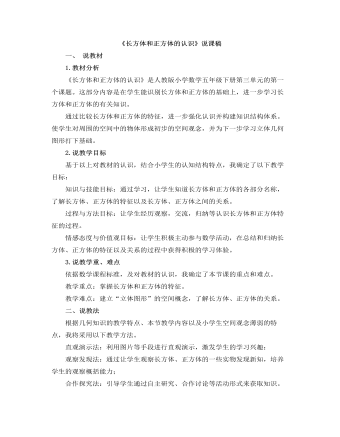
小学数学人教版五年级下册《长方体和正方体的认识》说课稿
3.说教学重、难点依据数学课程标准,及对教材的认识,我确定了本节课的重点和难点。教学重点:掌握长方体和正方体的特征。教学难点:建立“立体图形”的空间概念,了解长方体、正方体的关系。二、说教法根据几何知识的教学特点、本节教学内容以及小学生空间观念薄弱的特点,我将采用以下教学方法。直观演示法:利用图片等手段进行直观演示,激发学生的学习兴趣;观察发现法:通过让学生观察长方体、正方体的一些实物发现新知,培养学生的观察概括能力;合作探究法:引导学生通过自主研究、合作讨论等活动形式来获取知识。同时运用多媒体辅助教学,使学生的观察能力、抽象概括能力逐步提高。三、说学法为了使学生较好地掌握长方体和正方体的特征,并逐步形成空间观念,除了让学生通过观察来认识长方体和正方体的特征以外,在观察实物的基础上,通过动手操作,看一看,摸一摸,数一数,量一量,做一做来学习新知,同时以此来激发学生的学习兴趣,调动学生的积极性。
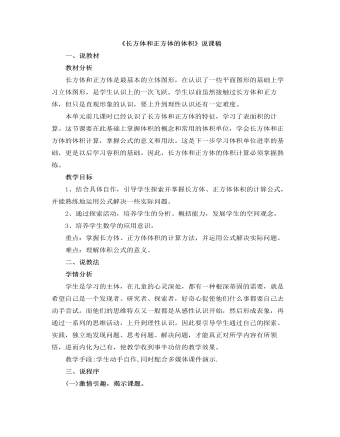
小学数学人教版五年级下册《长方体和正方体的体积》说课稿
本单元前几课时已经认识了长方体和正方体的特征,学习了表面积的计算。这节课要在此基础上掌握体积的概念和常用的体积单位,学会长方体和正方体的体积计算,掌握公式的意义和用法。这是下一步学习体积单位进率的基础,更是以后学习容积的基础。因此,长方体和正方体的体积计算必须掌握熟练。教学目标1、结合具体自作,引导学生探索并掌握长方体、正方体体积的计算公式,并能熟练地运用公式解决一些实际问题。 2、通过探索活动,培养学生的分析、概括能力,发展学生的空间观念。 3、培养学生数学的应用意识。 重点:掌握长方体、正方体体积的计算方法,并运用公式解决实际问题。 难点:理解体积公式的意义。
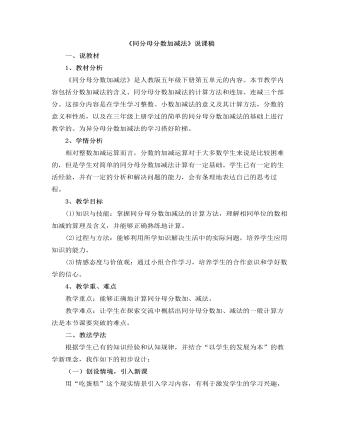
小学数学人教版五年级下册《同分母分数加减法》说课稿
1、教材分析《同分母分数加减法》是人教版五年级下册第五单元的内容。本节教学内容包括分数加减法的含义、同分母分数加减法的计算方法和连加、连减三个部分。这部分内容是在学生学习整数、小数加减法的意义及其计算方法,分数的意义和性质,以及在三年级上册学过的简单的同分母分数加减法的基础上进行教学的。为异分母分数加减法的学习搭好阶梯。2、学情分析相对整数加减运算而言,分数的加减运算对于大多数学生来说是比较困难的,但是学生对简单的同分母分数加减法计算有一定基础。学生已有一定的生活经验,并有一定的分析和解决问题的能力,会有条理地表达自己的思考过程。3、教学目标(1)知识与技能:掌握同分母分数加减法的计算方法,理解相同单位的数相加减的算理及含义,并能够正确熟练地计算。(2)过程与方法:能够利用所学知识解决生活中的实际问题,培养学生应用知识的能力。(3)情感态度与价值观:通过小组合作学习,培养学生的合作意识和学好数学的信心。

人教版新目标初中英语八年级上册How was your school trip教案2篇
“Go for it!” is based on “Task-Based Language Teaching”. It adheres to “The authenticity principle”, “The form-function principle”, “The task dependency principle” and “The principle of learning by doing”. These principles all accord with the demands of curriculum focus.In and of Grade Seven (II), “Go for it!”, students have learned “The Simple Past Tense”. And it appears again in of Grade Eight (I). teaches students more about how to talk about events in the past. In addition, it gives affirmative and negative statements in the past tense, such as the sentence patterns “Did you see …?” “Were there …?” “Did you go …?” As the first part of Unit 8, Section A opens with a picture presenting the last school trip in the aquarium and continues with several step-by-step practice activities, which are all good for students to master “The Simple Past Tense”. Doing well in Section A will help students integrate the new target language with that in Section B. Thus, they can describe the events in the past freely and foster their own ability of reflecting and practicing. II. Teaching ObjectivesTeaching objective is the beginning and aim of teaching activities. According to the overall goal of the English elementary course--- improve students' synthetic ability of language application, which should be based on the development of students’ “Language knowledge”, “Language skills”, “Character building”, “Learning strategies” and “Cross-cultural awareness”. The teaching objectives are described as follows(I). Knowledge objectivesi. Master the simple past tense of regular and irregular verbsii. Recite the new words and expressions about the last school trip in the aquarium, including their pronunciation and intonation

人教版新目标初中英语八年级上册Could you please clean your room教案3篇
一、 教学内容Section A 1a----1c二、 教学目标1.学习词汇do the dishes, make the bed, take out the trash, fold the clothes, do the laundry, sweep the floor, clean the living room.2.句型 Could you please clean your room? Yes, sure.三、 教学准备 学生预习本单元所有的词汇多媒体课件 活动表 奖品四、 教学过程Pre-task1. Warming upEnjoy ourselves. Watch cartoon Cinderella. 看动画片段《灰姑娘》导如入本课话题和新词汇“chores”美丽善良的鬼姑娘因继母的嫉妒,每天得做所有的家务。片段的主题使学生联想到本课的话题。2. learn new words and phrasesLook! What is she / he dong? 看图学习动词词组do chores, do the dishes, make the bed, take out the trash, fold the clothes, do the laundry, clean the living room.3. Guessing game.What is she doing ? 4. Pair work. 1a, Do you do these things at home? Write “Y” for “yes” and “N” for “no”.5. Listening . 1b , Peter’s chores or Mom’s chores?理解目标语Could you please clean your room? Yes, sure.Write “M” for Mom’s chores, “P” for Peter’s chores in the chart.6. PairworkLook at the picture,Ask your partner to do the chores that you see. 7. Interview Who is the most able at home? 1) What chores do you do at home? How often do you do the chores? Work in four, interview each of the students in the group, fill in the chart.

人教版新目标初中英语八年级上册How do you get to school教案2篇
Step Ⅶ Role play ( Work on 1b)1. First ask two students to read the dialogue to the class.Sa: How do you get to school?Sb: Well, I ride my bike to the subway station. Then I take the subway.2. Now work with a partner.Suppose you use two kinds of transportation to get to school \Hangzhou\Beijing... (bus, train, subway, walking, bike, etc.) Tell how you get there. You may use the phrases in 1a.3. Then ask different pairs of students to present their conversations to the class.Step ⅧListening1. Work on 2a(1) First ask students to read the list of information that Thomas wants to know.…where Nina lives.…how far from school she lives.…how long it takes to get to school.…how she gets to school.…what she thinks of the transportation.(2) Tell students what transportation and bus stop mean.bus stop 汽车站 transportation n. 运送;运输Then tell students we'll hear a recording. Please put a checkmark in front of each thing that Thomas wants to know.(3) Now play the recording for students.( Have students pay attention to the sample answer.) (4) Then correct the answers.

人教版新目标初中英语八年级上册What are you doing for vacation教案2篇
Teaching goals : 1. Words & phrases: babysit ,get back , fishing , rent , think about , decide(on) , tourist etc. 2. How to talk about future plans . 3. 现在进行时表示将来计划或行动. 4. 特殊疑问句(where , when , how long引导) Important and difficult points : Drills :What are you doing for vacation ? I’m watching TV . When are you going ? I’m going … . How long are you staying ? We’re staying for five days . Teaching aids : cards and a tape ,a large wall calendar . Period 1 Teaching procedures : Step 1Leading in1. Free talk . 2. Put up the wall calendar . T: I’m staying home on Saturday (pointing to next Saturday ).Ss repeat . Ss: I’m staying home on Saturday . T: OK. Today we’ll learn how to talk about future plans. Step 2Pre-task SB Page 13 , 1a . 1. Look at the picture carefully and tell what you see in the picture . 2. Write the activities from the pictures in the box and add some more . 3. Practice reading . Step 3While-task1. Using the activities we write in 1a to make conversations .For example :What are you doing for vacation ? I’m visiting my uncle . 2. Pairwork .Practice in pairs . 3. 用第三人称练习对话.

人教版新目标初中英语八年级上册What’s the matter教案2篇
She shouldn’t go to the party tonight.Step7. TaskT: You know, there are lots of problems in our life. If you are a doctor, please tell us how to solve the problem. I will divide you into 9 groups. Please work in groups. And then choose one of you to report your ideas.The following are the problems:I have a toothache.I am hungry. I have a sore throat.I am stressed out. I have a sore back.I am tired. I can’t sleep.I have a cold. I have a headache.Report: If you have a headache, you should go to bed early. You should see the doctor. You should eat some medicine. You shouldn’t wash your face with cold water.You shouldn’t sleep late.You shouldn’t swim.…..T encourages the students to give advice as much as possible.Homework:1. Chose one of the problems, and write down your advice2. Copy the new words这一步是用于热身的,同时也可以让他们复习一部分的表示人体部位的单词,扩充知识.学习语言的过程也是一个不断积累的过程,复习旧知识,增添新知识.通过小游戏,强化学生对Does she/he have…这个句子的运用能力.通过复习,自然的引到下面新知识的学习。充分利用表格,由句子到对话,再到文章,让学生循序渐进. 提高学生的综合语言运用能力,运用以前学过的知识来解决身边的问题.Period 5 (Section B 3a—3c, selfcheck)教学内容与分析:

人教版新目标初中英语九年级上册Where would you like to visit教案2篇
The First PeriodⅠ.Teaching Aims and DemandsKnowledge Objects(1) Key Vocabularytiring, educational, fascinating, thrilling, peaceful, exotic, trek, jungle, take it easy, explore, historic, site(2) Target LanguageWhere would you like to go on vacation?I’d like to trek through the jungle, because I like exciting vacations.2. Ability Objects(1)Train students to talk about places they would like to visit with the target language.(2)Train students to describe vacations with different adjectives.(3)Train students' listening skill.3. Moral Object,It′s more interesting to go on vacating somewhere instead of staying at home.Ⅱ. Teaching Key Points1. Key Vocabularytiring, educational, fascinating, thrilling, peaceful, exotic, trek, jungle, take it easy, explore, historic, site2. Target LanguageTalk about different places with the target language.Ⅲ. Teaching Difficult Points1. Describe vacations with different adjectives.2. Talk about different places with the target language.Ⅳ. Teaching Methods1. Teaching by illumination2. Teaching by doing chain drills3. Teaching by pairworkⅤ. Teaching Aids1. A tape recorder2. Some pictures of different places with famous views

人教版新目标初中英语八年级上册Can you come to my party教案3篇
Step 3 (3b)First, tell the students when we talk about our future plans, we often use: I’m+verb+ing When we talk about what we must do, we use have to. Ask the students to fill in the blanks in 3b. The answers are: shopping, go to see, a test, I’m going, my family. Step 4 (3c)Let the students write an e-mail message to a friend. Say why you can’t visit next. Before the exercise, ask the students to give some possible answers and write them on the blackboard. So the students will feel easy to finish the writing exercise. After they finish it, Let them to correct it in groups first. Each group chooses theirs best one to read in front of the whole class. Step 5 ( planning a party )First read the conversation in the box together. Then ask the students to turn to page 88.Write down everything you have to do next week. Write in all the things you have to do . Ask the students to look at the list. Ask them “What day are you free?” This is when you can have your party. Step 6 (Self check 1 )Let the students to fill in the blanks with the words given. Change the forms of the words if possible. Then make their own sentences. The answers are: visit, playing, have to, study, comeStep 7 (Self check 2)Imagine you are Marie. Read the information and look at your schedule. Write replies to the invitation.

人教版新目标初中英语八年级上册What’s the best radio station教案2篇
教学重点和难点:运用所掌握的语言描述,比较不同地点的特点。在练习中学习掌握英语比较级和最高级的用法。课前准备分配小组,每组五至六人。通过上网或翻阅报刊杂志等方法,确定旅游线路,做出基本的旅游计划。教学设计:本节课流程图 学法指导:1.由于这是一堂新课,在教学中应注意面向全体,发挥学生的主体性,引导学生积极参与,激发学生的求知欲和学习积极性,指导学生积极思维,主动获取知识,养成良好的学习方法。逐步学会独立解决问题。总之要尽可能调动学生的非智力因素促进智力因素的发展。教法选择:1.电化教学法2.课堂讨论法3.任务型教学法采用这些方法的目的是为了充分调动学生的学习积极性,使学生变被动学习为主动学习。通过电脑形象的演示,加强印象,提高兴趣,突破难点,提高教学效率,进而增大教学的容量和信息量。充分体现教师为主导,学生为主体的教学原则。

人教版新目标初中英语九年级上册Teenagers should be allowed to choose their own clothes教案2篇
Step 1 Greeting Greet the class and check the homeworkStep 2 A duty report The S on duty gives a report on the rules in his home and lead in 3a “Sun Fei’s and Wu Yu’s rules” Step 3 ReadingSs read the conversation and write the two girls’ rules in the chart. Check the answers.Get Ss to read after the tape and then read aloud by themselves. Then, T explains the language points.Step 4 Pairwork 3bRole play. Use the information in chart to practice with the conversation in 3a covered. They can look at the sample conversation in the right box.Step 5 Task 2 “Who’s the best reporter?”Make a survey by asking any 5 students the questions in the chart in activity 4. Then give out a report about it. See who is the best reporter? And the best reporter will get a nice ball-pen.Step 6 Summary and homework:Write out the report in your exercise-books.Period ThreeStep 1 Greeting and a duty reportThe S gives a duty report talking about his experience of being late for school. Lead in the question “Do you ever get to school late? How often do you get to school late? Always, usually, sometimes, or never?Step 2 1a Get Ss to finish writing.Step 3 Pairwork 1b Get Ss to talk about their answers with their partners using the sample conversation in the box on the right.Step 4 Listening practice2a Lead-in: What will happen if you get to school late? What about Peter? Let’s listen to a conversation between Peter and his father. Get Ss to finish 2a (As usual, for the first time, Ss only listen.) Check the answers.
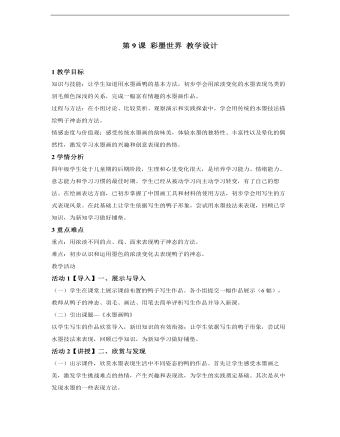
小学美术人教版四年级上册《第9课彩墨世界》教学设计说课稿模板
2学情分析四年级学生处于儿童期的后期阶段,生理和心里变化很大,是培养学习能力、情绪能力、意志能力和学习习惯的最佳时期。学生已经从被动学习向主动学习转变,有了自己的想法。在绘画表达方面,已初步掌握了中国画工具和材料的使用方法,初步学会用写生的方式表现风景。在此基础上让学生依据写生的鸭子形象,尝试用水墨技法来表现,回顾已学知识,为新知学习做好铺垫。
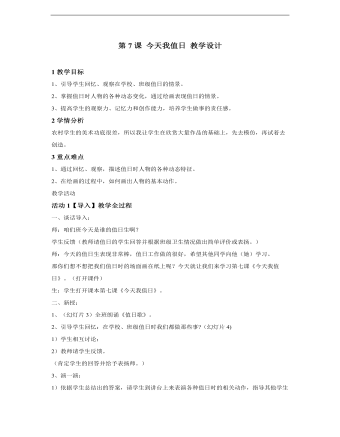
小学美术人教版四年级上册《第7课今天我值日》教学设计说课稿
一、谈话导入:师:咱们班今天是谁的值日生啊?学生反馈(教师请值日的学生回答并根据班级卫生情况做出简单评价或表扬。)师:今天的值日生表现非常棒,值日工作做的很好,希望其他同学向他(她)学习。那你们想不想把我们值日时的场面画在纸上呢?今天就让我们来学习第七课《今天我值日》。(打开课件)生:学生打开课本第七课《今天我值日》。
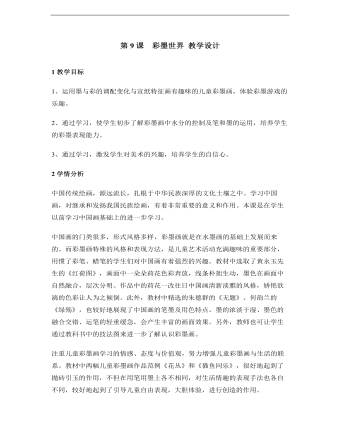
小学美术人教版四年级上册《第9课彩墨世界》教学设计说课稿
2学情分析中国传统绘画,源远流长,扎根于中华民族深厚的文化土壤之中。学习中国画,对继承和发扬我国民族绘画,有着非常重要的意义和作用。本课是在学生以前学习中国画基础上的进一步学习。中国画的门类很多,形式风格多样,彩墨画就是在水墨画的基础上发展而来的。而彩墨画特殊的风格和表现方法,是儿童艺术活动充满趣味的重要部分,用惯了彩笔、蜡笔的学生们对中国画有着强烈的兴趣。教材中选取了黄永玉先生的《红荷图》,画面中一朵朵荷花色彩奔放,线条朴拙生动,墨色在画面中自然融合,层次分明。作品中的荷花一改往日中国画清新淡雅的风格,娇艳欲滴的色彩让人为之倾倒。此外,教材中精选的朱德群的《无题》、何韵兰的《绿殇》,也较好地展现了中国画的笔墨及用色特点。墨的浓淡干湿、墨色的融合交错、运笔的轻重缓急,会产生丰富的画面效果。另外,教师也可让学生通过教科书中的技法图来进一步了解认识彩墨画。
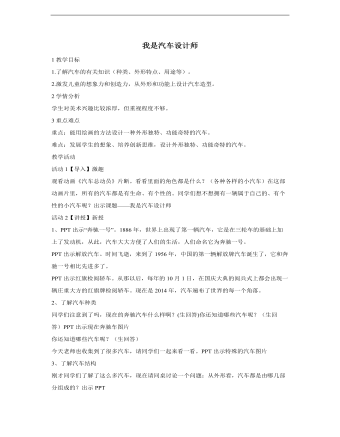
小学美术人教版四年级上册《第10课我是汽车设计师》教学设计说课稿
活动1【导入】激趣观看动画《汽车总动员》片断。看看里面的角色都是什么?(各种各样的小汽车)在这部动画片里,所有的汽车都是有生命、有个性的。同学们想不想拥有一辆属于自己的、有个性的小汽车呢?出示课题——我是汽车设计师活动2【讲授】新授1、PPT出示“奔驰一号”。1886年,世界上出现了第一辆汽车,它是在三轮车的基础上加上了发动机,从此,汽车大大方便了人们的生活,人们命名它为奔驰一号。PPT出示解放汽车。时间飞逝,来到了1956年,中国的第一辆解放牌汽车诞生了,它和奔驰一号相比先进多了。
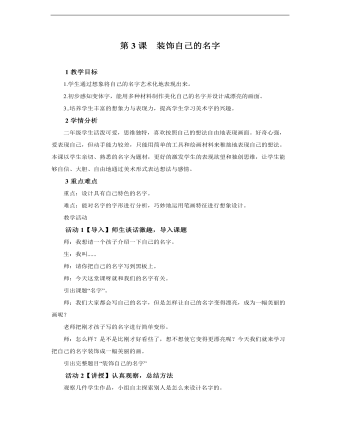
小学美术人教版二年级上册《第3课装饰自己的名字》教学设计说课稿
2学情分析二年级学生活泼可爱,思维独特,喜欢按照自己的想法自由地表现画面。好奇心强,爱表现自己,但动手能力较差,只能用简单的工具和绘画材料来稚拙地表现自己的想法。本课以学生亲切、熟悉的名字为题材,更好的激发学生的表现欲望和独创思维,让学生能够自信、大胆、自由地通过美术形式表达想法与感情。3重点难点重点:设计具有自己特色的名字。难点:能对名字的字形进行分析,巧妙地运用笔画特征进行想象设计。教学活动

小学美术人教版三年级上册《第1课魔幻的颜色》教学设计说课稿
2学情分析1、学生学习美术的态度:很多学生上美术课时会抱着“玩”的心理,针对学生的这种思想,我们应当根据学生的年龄特点,在备课过程中注意挖掘教材中有趣的内容,寻找学生的兴趣点,充分地让美术教学体现出身心愉悦的活动特点,寓教于乐,防止把美术课变成一种枯燥的令人生厌的劳动。2、学生认知发展分析:在美术课堂上常常听到这样的声音:“我画(做)不好”、“我不会画(做)”;这就需要美术教师在课堂教学中注重引导学生感受、观察、体会、表现,让学生在一系列“玩中学”的活动过程中慢慢树立信心。所以围绕本课教学目的和任务,我采用情境教学法、观察对比法、直观演示法三种教学方式;学生运用四种方法进行学习:观察法、讨论法、实践体验法、合作交流法;努力营造一个开放和谐的课堂氛围,顺利完成教学目标。
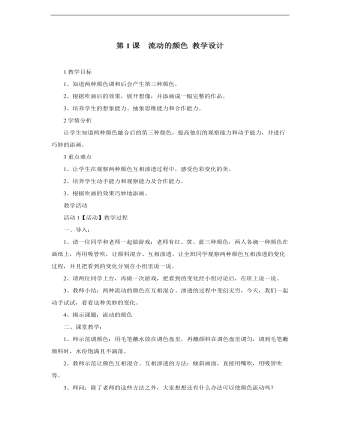
小学美术人教版二年级上册《第1课流动的颜色》教学设计说课稿
一、导入:1、请一位同学和老师一起做游戏:老师有红、黄、蓝三种颜色,两人各滴一种颜色在画纸上,再用吸管吹,让颜料混合、互相渗透。让全班同学观察两种颜色互相渗透的变化过程,并且把看到的变化分别在小组里说一说。2、请两位同学上台,再做一次游戏,把看到的变化经小组讨论后,在班上说一说。3、教师小结:两种流动的颜色在互相混合、渗透的过程中变幻无穷,今天,我们一起动手试试,看看这种美妙的变化。4、揭示课题:流动的颜色
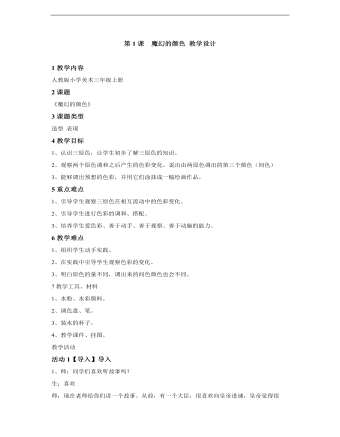
小学美术人教版三年级上册《第1课魔幻的颜色》教学设计模板说课稿
3课题类型造型表现4教学目标1、认识三原色,让学生初步了解三原色的知识。2、观察两个原色调和之后产生的色彩变化,说出由两原色调出的第三个颜色(间色)3、能够调出预想的色彩,并用它们涂抹成一幅绘画作品。5重点难点1、引导学生观察三原色在相互流动中的色彩变化。2、引导学生进行色彩的调和、搭配。3、培养学生爱色彩、善于动手、善于观察、善于动脑的能力。